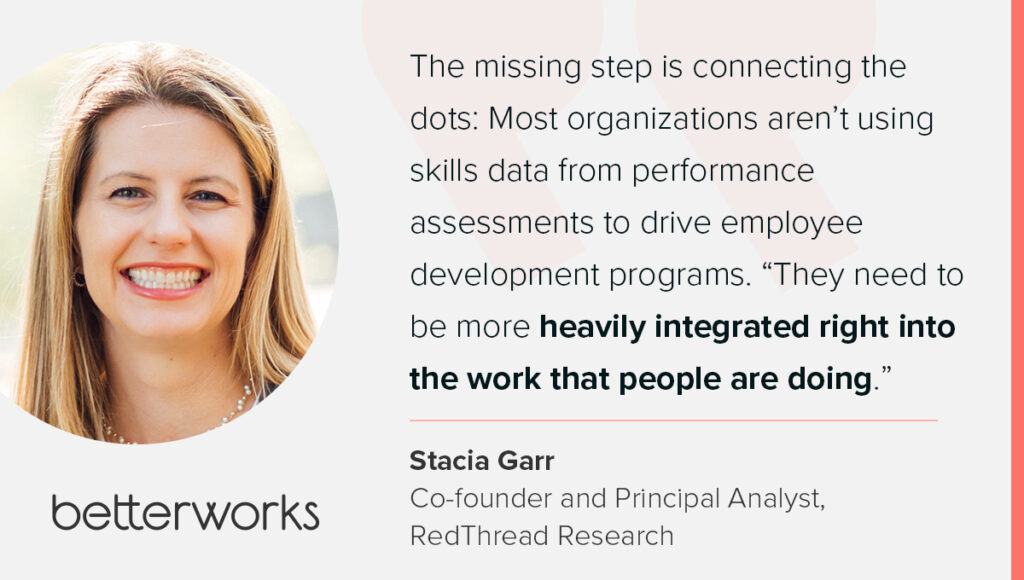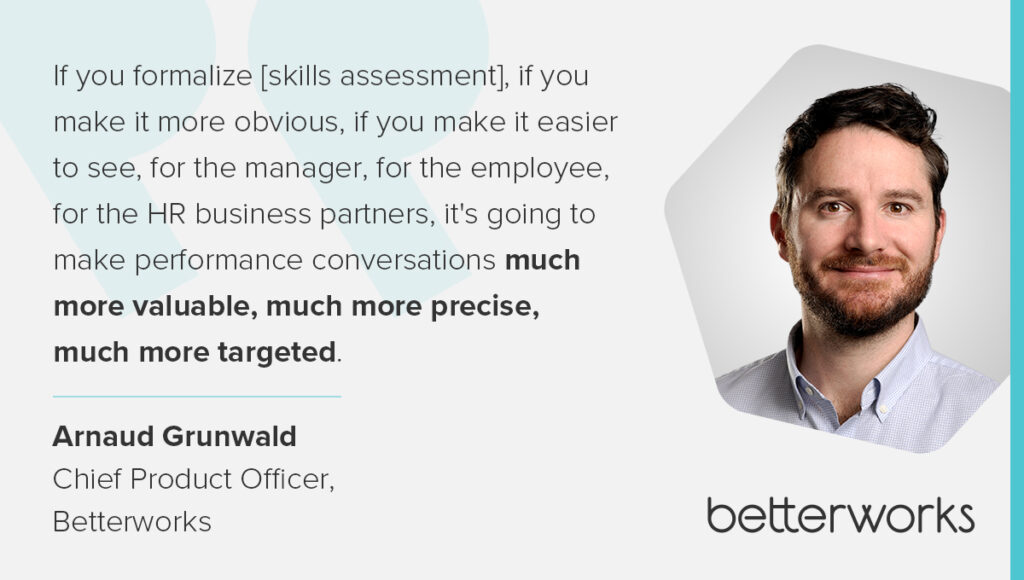Skills have taken center stage in talent management discussions — and with good reason. With organizations facing new and evolving demands almost daily, there’s no way you can hire fast enough for new skills. Instead, you need to define and develop more of those skills internally.
“It’s important for individuals, like employees and managers, but also for organizations, to be able to speak that language of skills,” said Arnaud Grunwald, chief product officer at Betterworks, during his talk at EmpowerHR Americas.
The challenge for many organizations, however, has been designing and implementing actionable skills development programs. Performance data could be the key to solving this puzzle and creating a practical approach to skills management.
At EmpowerHR, Arnaud joined RedThread Research co-founder and principal analyst Stacia Garr to share how to leverage skills data to transform how organizations develop, assess, and mobilize the workforce.
In this excerpt from the session, Arnaud explains how to drive skills-based performance by helping employees understand what they get out of it.
Why take a skills-based approach?
A skills-based approach is based on three key ideas, Stacia said, all of which require strong HR processes to drive business outcomes. First, having a precise knowledge of skills requirements helps leaders make better decisions by matching the right people with the right jobs.
Second, a targeted skills approach supports internal mobility. “If we understand the skills that people have, we’ll be able to understand how they might be able to move in the organization,” Stacia said, “and thus enable them to have better careers and create more flexibility.”
Internal mobility benefits individuals by providing clear avenues for growth while also improving organizational agility and adaptability in the face of change.
Third, a skills-based approach promotes equity in terms of job opportunities and progression potential. “They can move more freely within organizations,” Stacia said, “and they’re not reliant on the information or knowledge networks that exist in order to be able to access new opportunities.”
Do you already assess skills in performance conversations?
While the benefits of a skills-based approach are clear, creating formal, successful programs can be challenging. The good news is that your performance management program might have already laid the foundation. “Skills are already deeply embedded in performance practices, and specifically within performance assessment,” Stacia said.
Managers are most likely to assess job responsibilities and business goals during performance conversations. That said, nearly half (45%) of organizations surveyed by RedThread Research also assess employee performance based on competencies and skills, Stacia said.
The missing step is connecting the dots: Most organizations aren’t using skills data from performance assessments to drive employee development programs. “They need to be more heavily integrated right into the work that people are doing,” Stacia explained.
Part of the problem is while performance management processes might include skills assessments, they aren’t intentionally built into those processes. An integrated approach could help employees struggling to meet goals, as managers can use skills data to identify roadblocks and growth opportunities.

How can you harness data to drive skills development?
While nearly 50% of organizations have a framework for collecting and assessing skills, most lack formal programs for helping managers and employees understand and apply that data. The benefits of a formal approach are clear.
“If you formalize it, if you make it more obvious, if you make it easier to see, for the manager, for the employee, for the HR business partners,” Arnaud said, “it’s going to make performance conversations much more valuable, much more precise, much more targeted.”
In many organizations, such skills data is fragmented, scattered within HR information systems, and often siloed from other talent data. By consolidating this data into comprehensive talent profiles, organizations can gain a holistic view of each employee’s skills. That unlocks new applications for talent mobility, succession planning, and strategic workforce planning. Here’s where technology can bridge the gap. User-friendly data visualization tools can translate complex skills data into easily digestible charts and graphs. Additionally, QR code generators can be a powerful asset. Imagine including a QR code within an employee’s talent profile that links directly to more detailed information about their skills, certifications, or past performance reviews. To create such QR codes, using a free QR Code Generator can simplify the process while ensuring customization and tracking options.

Betterworks’ new talent profile, to be released later this year, will help validate employee skills through internal data sources — including performance assessments and learning management systems. With the right data, AI tools will help employees understand their internal growth opportunities — and where they’re most likely to excel.
Want to learn more? Catch EmpowerHR on demand to get more insights on improving performance and helping people thrive at work.
Missed EmpowerHR?


